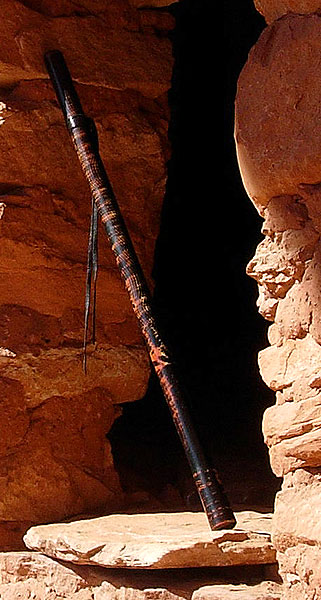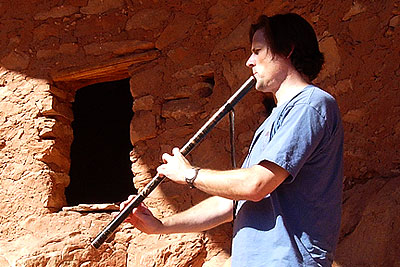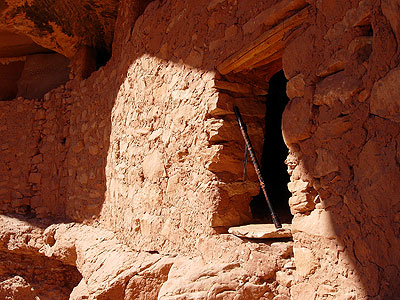
THE ANASAZI FLUTE
In this posting we're going to look at a completely different type of Native American flute. The Ancestral Pueblo or "Anasazi" flute, which is currently being reproduced by Michael Graham Allen aka Coyote Oldman. He is making these from measurements of artifacts that were provided by Dr. Richard Payne, an avid collector, historian and author. Unlike all the other Native American flutes (NAF) we've looked at so far, this flute pre dates any European influence. In this sense it is a true Native American flute, but as we shall see below, it shares many characteristic with flutes throughout the world.
 Examples of this flute can be heard on Scott August's latest release "Lost Canyons" available from Cedar Mesa Music.
Examples of this flute can be heard on Scott August's latest release "Lost Canyons" available from Cedar Mesa Music.An Echoes radio "CD of the Month" this release features three pieces for solo Anasazi flute and three pieces for Anasazi flute and world instruments.

AN END-BLOWN FLUTE
The major difference between the Anasazi flute and the modern (1800-present day) Native America flute is how the sound is produced. The Anasazi flute is not a fipple flute, like the modern NAF, but is an end-blown, or rim-blown, flute. End-blown flutes are some of the oldest flutes in the world. One of the oldest is the Ney from the Middle East, which dates back to the time of the Pyramids. In Turkey there are the Nai and the Kaval. The most well-know end-blown flute is the Japanese shakuhachi. In the Western Hemisphere an end-blown flute called the Quena can be found along side Pan-Pipes (Zampoñas) in South American, while in North America the Hopi culture has an end-blown flute that is still used for ceremonies, and the Southern California native cultures also have a end-blown flute made of Elderberry, but it is no longer in common use.
PLAYING TECHNIQUE
Unlike a modern NAF, the player has to learn how to place their lips against the mouth piece to produce a sound. It can take an hour to a week for the beginner to produce their first note! I was lucky, getting notes within the first hour, but even now, four months later, there are times when I have difficulty making a sound.

The flute is a hollow tube. The mouth piece is a slight depression on the top side of the tube. The player covers most of the lower part of the tube with their lower lip and chin while blowing a stream of air across the depression. If the stream air doesn't hit the flute just right no sound, or high squeaking overtone results.

THE "ANASAZI" SCALE
This flute is 30" long and has a bore of 3/4" at the far end. It is made of cedar. The root note is G# and has a scale that is surprisingly close to the modern NAF scale in that it is pentatonic. But the mode is differetnt. This scale is a major pentatonic scale with the addition of a minor 3rd. The pitches are G#, A#, B, C, D#, F, then the Octave. Notes above, and including the Octave that can be played by over-blowing are: G#, A#, B, C and even D# and a higher G# -two octaves above the root. With alternate fingerings a player can get some chromatic pitches, such as G (half step below the octave), F#, and E. As you can see in the photo above the finger holes are much different than the modern NAF, being closer to the bottom of the pipe and there is a larger gap between each set of three holes than on the NAF.
Listen to a Sample of this flute.
HISTORY

This type of flute dates back to AD 500. During this time the cultures of the Four Corner area of North America were called Basketmakers. Pottery was just beginning to be made, but weaving was the at it's height during this time. This was before the cliff dwelling of Mesa Verde, and the giant pueblos of Chaco Canyon. People lived in Pit-houses, a semi-subterranean "earth-lodge" with an earth covered log roof. This was also the high point of Rock Art creativity, especially so of Kokopelli. This flute is Kokopelli's flute.
In 1931 Earl Morris, who reconstructed the great Kiva at Aztec, NM, was excavating in the Prayer Rock district of northern Arizona, near Canyon de Chelly, when he unearthed four flutes in a cave he later named Broken Flute Cave. These flutes were made of Box Elder which has a soft inner pith that can easily be removed. (End-blown flutes from southern California were made of Elderberry which also has a soft inner pith.)
Morris also found similar flutes in Mummy Cave in Canyon del Muerto, part of Canyon de Chelly in 1934. These include ones with only five holes. These five hole flutes match Hopi flutes from the 1900's. A living history that stretches back 1,500 years! These flutes are reported to be in the collection a the University of Colorado, Boulder.
Morris describes the Mummy Cave find In a National Geographic Magazine article. He describes that the flutes found were buried with "The body...of an old man, surely once a priest or chief. Beside the usual offerings of beads, baskets, and sandals, there lay above his buckskin wrapping a flute, one end beneath the chin, the other between the thighs. ...
Along the left side was a mass of wooden objects, all readily perishable, hence extremely rare in perfect condition. Conspicuous among them were bone-tipped flint flakers with which knives and projectile points were made, several spears, four handsomely wrought spear throwers, and three more flutes."
Note: In my research on these flutes, especially as regards Morris' finds there are some discrepancies with dates that I have yet to sort out.
HEAR MORE
To hear more of the Anasazi flute sign up for my quarterly free mp3 downloads, through my free E-mailing list.
References:
Campbell, Grant, Canyon de Chelly: It's people and rock art, 1978, University of Arizona, Tucson.
Clint Goss, 2005, www.flutekey.com/brokenflutecave.
Robert Gatliff: 2005, Personal Correspondence.

© Cedar Mesa Music